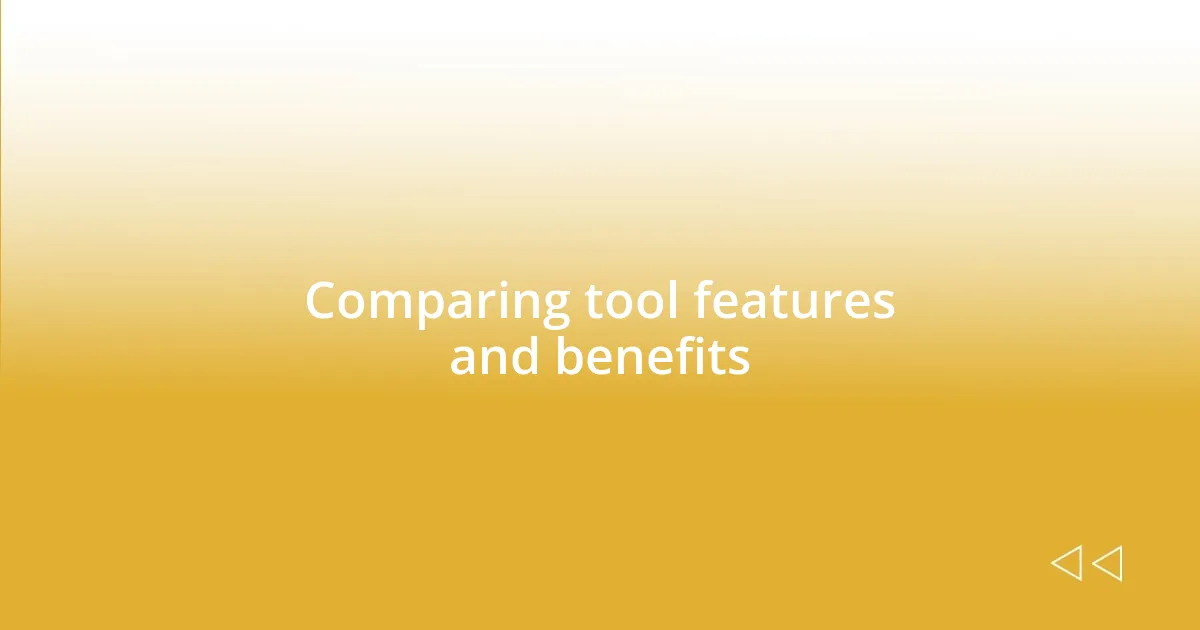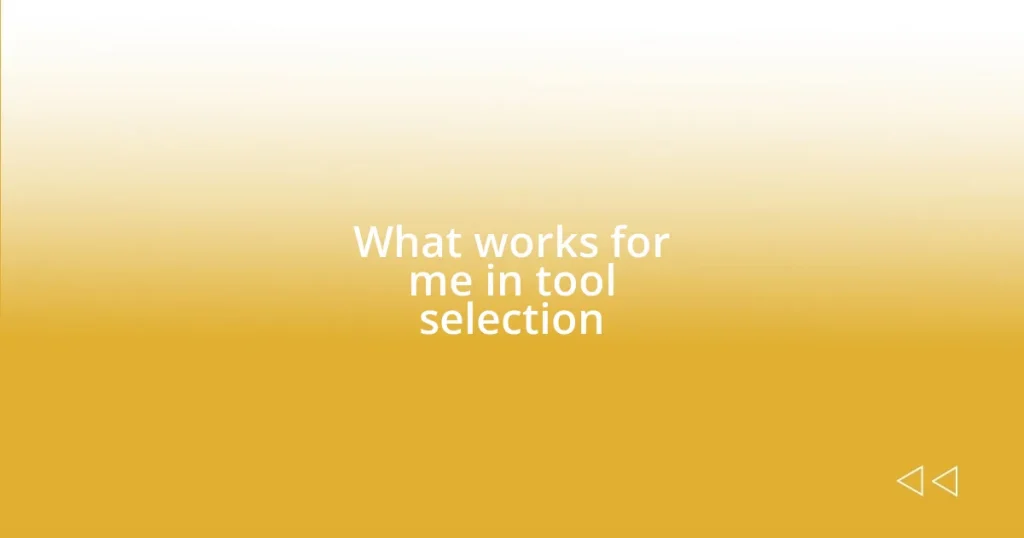Key takeaways:
- Establish clear criteria and evaluate essential functions, user experience, and integration capabilities before selecting tools.
- Hands-on testing of tools is crucial to uncover real user experiences and ensure good fit with existing workflows.
- Gather feedback from peers to gain insights and discover potential pitfalls that might not be apparent during research.
- Final decisions should combine intuition, testing, and feedback to ensure confidence in tool selection and alignment with personal or team needs.

Understanding my tool selection process
When I embark on tool selection, I often start with a clear set of criteria that resonate with my specific needs. For instance, I once spent weeks researching project management software; I remember feeling overwhelmed by so many options. This led me to ask myself: What are the non-negotiables for my workflow? That clarity really helped narrow down my choices.
I think intuition plays a vital role in the process, too. I recall testing tools that seemed promising but just didn’t feel right in use. Did you ever find yourself logging into a software only to feel frustrated with its layout? It’s that gut feeling that often tells me more than any feature list ever could.
Finally, feedback can be a game changer. I frequently consult colleagues or online communities when I have shortlisted a few options. Their experiences can reveal hidden pitfalls or benefits I hadn’t considered. Have you ever regretted a tool choice only to realize others had similar experiences? Those conversations often guide me toward more informed decisions, ultimately making me feel more confident in my tool selections.

Evaluating my specific needs
When evaluating my specific needs, I find it crucial to reflect on the tasks I regularly perform. For instance, during a recent tool selection for graphic design, I realized my essential requirement was seamless collaboration. I had previously struggled with software that isolated my work from teammates, leading to miscommunication and frustration. Recognizing this need helped me prioritize collaborative features over flashy extras.
Here are some key considerations I keep in mind when assessing my needs:
- Essential Functions: What core features do I use daily?
- User Experience: How intuitive is the interface?
- Integration Capabilities: Does it play well with my existing tools?
- Scalability: Will it grow with my needs?
- Cost vs. Value: Am I getting good value for my investment?
Taking the time to assess these areas not only streamlines my selection process but also gives me peace of mind that I’m choosing tools that genuinely fit into my workflow.

Researching available tools
When I’m diving into researching available tools, the process can be a double-edged sword. There’s so much information out there, which can sometimes feel overwhelming. I vividly recall spending nights sifting through reviews and articles, hoping to find that perfect fit. The more I searched, the more I realized the importance of understanding not just the features of a tool, but also the experiences other users had with it. Have you ever found yourself lost in a sea of information, wishing for a straightforward answer? That’s often how I felt, but focusing on user reviews helped me cut through the noise and hone in on what genuinely mattered.
I also make it a point to explore comparison websites. I remember coming across a particularly helpful site that allowed me to filter tools based on my specific requirements. It was like having a personalized recommendation tool at my fingertips. It made the exhausting task of weighing options into something much more manageable. When I found a tool that ticked all the right boxes, I felt a surge of excitement. It reminded me of the thrill of uncovering a hidden gem in a crowded market, and I couldn’t wait to dive deeper into my top choices.
Another key aspect is to categorize tools based on their intended use. Understanding the different segments—like project management versus design software—has always helped clarify my options. I once created a simple spreadsheet where I laid out all my findings. Each tool was in its own column, and I noted specific features and user feedback. This organized approach not only made it easier to visualize my options but also reduced my anxiety about making a wrong choice. Believe me, having that visual representation really transformed my approach to research.
| Tool Type | Key Feature |
|---|---|
| Project Management | Task tracking |
| Graphic Design | Collaboration options |

Comparing tool features and benefits
When it comes to comparing tool features and benefits, I’ve found that a direct side-by-side analysis often reveals unexpected insights. For example, I once faced a choice between two project management tools—one offered a robust feature set, while the other excelled in user-friendliness. Initially, I was drawn to the first tool’s long list of features, but after testing both, the simplicity and ease of the second tool made a significant impact on my workflow. Have you ever chosen complexity over convenience, only to regret it later?
I also like to keep an eye on special benefits that might not be immediately obvious. Just recently, I noticed that a tool advertised as basic had a hidden gem—a fantastic community support forum filled with templates and tips. This little detail can mean a lot; a feature that seems minor might open the door to richer functionality based on real-world experiences shared by users. It’s those unmeasured perks that often tip the balance for me.
Furthermore, I’ve learned that it’s the less quantifiable aspects of tools that frequently determine their true value. For instance, while comparing email marketing software, I came across one that had a more intuitive interface but offered slightly fewer automation features than its competitor. Ultimately, the smoother user experience outweighed the missing functions because it saved me time and frustration. Can you remember a time when you prioritized usability over an extensive feature list? For me, that was a turning point in my decision-making process. Evaluating features isn’t just about the numbers—it’s about how those features fit into your unique workflow.

Testing tools before making decisions
One of the most impactful strategies I’ve adopted is to test tools firsthand before making a final decision. I remember this one time when I was considering a new design software; I decided to take advantage of the free trial it offered. Launching the software for the first time, I was excited yet apprehensive. Would it really meet my needs? But diving into the interface and playing around with its features opened my eyes. It was a pivotal moment that emphasized the importance of hands-on experience.
I often ask myself: why settle for theoretical understanding when I can experience a tool in action? Testing tools has allowed me to uncover nuances that specifications don’t reveal. For instance, I once trialed a project management platform that looked great on paper, but during my usage, I struggled with clunky navigation. This became a dealbreaker for me, illustrating that a tool’s user experience can significantly impact my productivity. Have you ever made the mistake of sticking with a tool simply because it seemed fine in theory?
Furthermore, I’ve found that testing helps me gauge how well a tool integrates with my existing workflow. There was a time when I tried out a marketing platform, only to find that it didn’t sync well with my email service. The whole experience was jarring and disrupted my rhythm. After that, I made it a priority to ensure compatibility during my testing phase. The lesson I learned is simple: there’s no substitute for getting my hands dirty. It’s an experience that can’t truly be replicated through research alone.

Gathering feedback from peers
Gathering feedback from peers has been an eye-opening part of my tool selection process. I remember discussing a content management system with a colleague who had been using it for a while. As we talked, I learned about quirks I wouldn’t have noticed during a typical demo, like how its analytics could feel overwhelming at first but became incredibly useful with some practice. Have you ever discovered something valuable through a simple conversation? It’s those real-user insights that often guide my choices.
I also find it helpful to create an informal feedback loop with my network. After I switched to a new time-tracking tool, I encouraged my team to share their experiences. One team member pointed out a feature that streamlined our billing process, a detail that completely changed how I viewed the tool’s value. It’s fascinating how collective experiences can lead to a broader understanding; when we share our findings, we often see aspects we wouldn’t have caught on our own.
The emotional weight of peer feedback cannot be overstated. There was one time when I was on the fence about a collaboration platform. Hearing my peers rave about how it transformed their teamwork made me realize that I was missing out. Their enthusiasm and personal stories convinced me to take the leap, and it paid off. Have you ever felt that wave of FOMO (fear of missing out) push you toward a decision? It’s one of those moments that highlights the importance of community input in making informed choices.

Making the final selection decision
When it comes to making the final selection decision, I often find myself weighing my experiences against my research. For example, after testing a tool that seemed to fit perfectly on paper, I realized its support system was lacking during my trial. This oversight ended up leaving me feeling stranded when I had questions. Trust me, I learned that gut feelings, backed by actual use, can reveal much more than trendy features or impressive specs ever could.
There’s also a certain thrill in making that final call, especially when I reflect on my journey to the decision. I recall a time when I was poised to select a project management tool, feeling the exhilaration wash over me as I reviewed my notes and feedback. Did it check all the boxes? Would it harmonize with my workflow? The weight of those questions made me realize how crucial it was to feel genuinely confident about the choice. It’s a blend of logic and intuition that guides my decision-making process.
The aftermath of my choice is equally revealing. Once, after selecting a communication tool based on a mix of feedback and instinct, I felt an urgent thrill while introducing it to my team. Their reactions were priceless. Observing how quickly they embraced the new platform, I felt a sense of relief and pride, knowing I had made the right choice. Have you ever experienced that rush of excitement as a decision falls into place? It’s in those moments that I truly appreciate the culmination of testing, peer insights, and my instincts guiding me to the right decision.















